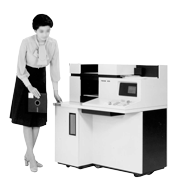Announced in August 1978, the FACOM 6312B was an OCR that could read handwritten characters (letters, numbers, symbols, and kana characters).
The FACOM 6312B’s most significant technological advance was replacing the conventional control system, which used a custom processor embedded in the hardware logic, with a control system using a commercially available microprocessor unit (MPU) and software (firmware), which was first for the industry. Firmware running on the MPU controlled paper feeding and image scanning from the sensors. Furthermore, firmware and a reference dictionary containing character definitions were used to control the character recognition process, which had previously been done with hardware logic circuits. Processing using hardware logic circuits was very fast, provided that the logic was relatively simple. However, as the complexity of character recognition processing grew, it became more important to switch to software, including firmware, that could keep up with this complexity. Controls using commercially available MPUs and software were widely used for OCR functions in the following years and this methodology became the foundation for advancing OCR functionality.
The MPUs at the time were slow 8-bit processors, so Fujitsu used multiple CPUs to obtain sufficiently fast speeds on the FACOM 6312B. Functions were divided among the CPUs as shown below and the CPUs ran in parallel to execute processes.
- Control over paper-feeding, the scanner, the operator panel, the host computer interface, and the floppy disk drive
- Character recognition processing (a technology called reflection method [Note 1] was used to recognize handwritten characters)
Note 1: The reflection method was one technique of recognizing characters. It recognized characters by identifying the characteristics of the lines and spaces between lines that form a character. More specifically, it examined each character enclosed in a square box. It created a pattern from where the character’s lines (called reflection lines) could be seen extending up, down, left, or right from the box. The character was recognized by identifying the unique characteristics of each pattern. This method was effective in quickly recognizing characters with relatively few strokes. Fujitsu used the reflection method for the first time on the FACOM 6312 series.


